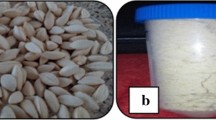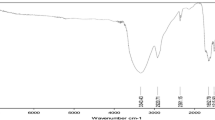Abstract
Peganum harmala seeds were assessed as biosorbent for removing Pb2+, Zn2+and Cd2+ ions from aqueous solutions. The effects of various parameters such as the aqueous solution pH, the contact time, the initial metal concentration and the amount of adsorbent in the process were investigated. The adsorption efficiencies increased with pH. It was found that about 95 % of lead, 75 % of zinc and 90 % of cadmium ions could be removed from 45 ml of aqueous solution containing 20 mg l−1 of each cation with 2 g of adsorbent at pH 4.5 after 15 min. The quantitative desorption of cadmium from adsorbent surface was achieved using 10 ml of a 0.5 M nitric acid solution. This condition was attained for lead and zinc ions with 10 ml of 1 M hydrochloric acid solution. Kinetic investigation of the process was performed by considering a pseudo-second-order model. This model predicts the chemisorption mechanism of the process. Langmuir, Freundlich, Temkin and Dubinin–Radushkevich models were tested for describing the equilibrium data. It was found that the Freundlich model describes the experimental data resulting from the adsorption of lead ions. However for cadmium and zinc ions, the adsorption equilibria were interpreted with the Langmuir model.







Similar content being viewed by others
References
Abdel-Ghani NT, Hefny M, El-Chaghaby GAF (2007) Removal of lead from aqueous solution using low cost abundantly available adsorbents. Int J Environ Sci Technol 4:67–73
Abo-Ghander NS, Rahman SU, Zaidi SMJ (2006) A modified electrodialytic cell to recover heavy metals from wastewater. Port Electrochim Acta 24:367–376
Agedilova MT, Turmukhambetov AZh, Schultz EE, Shakirov MM, Adekenov SM (2006) Components of the aerial part of Peganum harmala. Chem Nat Compd 42:226–227
Babel S, Kurniawan TA (2003) Low-cost adsorbent for heavy metal uptake from contaminated water: a review. J Hazard Mater B97:219–243
Bailey ES, Olin TJ, Bricka RM, Adrian DD (1999) A review of potentially low cost sorbents for heavy metals. Water Res 33:2469–2479
Bakalár T, Búgel M, Gajdošová L (2009) Heavy metal removal using reverse osmosis. Acta Mont Slov 14:250–253
Canet L, Ilpide M, Seta P (2002) Efficient facilitated transport of lead, cadmium, zinc and silver across a flat sheet-supported liquid membrane mediated by lasalocida. Sep Sci Technol 37:1851–1860
Casagrande JC, Mouta ER, Soares MR (2009) Adsorption edge study about cadmium, copper, nickel and zinc adsorption by variable charge soils. Geophysical Research Abstracts, 11, EGU2009-9628
Dean JA (1995) Analytical chemistry handbook. McGraw-Hill, New York
Dela Rosa G, Renel-Avila HE, Bonilla-Petriciolet A, Cano-Rodríguez I, Valasco-Samos C, Martínez-ernández AL (2008) Recycling poultry feathers for Pb removal from wastewater: kinetic and equilibrium studies. Int J Chem Biol Eng 4:185–193
Esalah J, Husein MM (2008) Removal of heavy metals from aqueous solution by precipitation–filtration using novel organo-phosphorus ligands. Sep Purif Technol 43:3461–3475
Fenglian F, Qi W (2011) Removal of heavy metal ions from wastewaters: a review. J Environ Manag 92:407–418
Hami M, Fathi SAM, Yaftian MR, Noushiranzadeh N (2010) Solid phase extraction of copper(II) ions using C18-silica disks modified by oxime ligands. J Hazard Mater 179:289–294
Ho YS, Ofomaja AE (2006) Pseudo second-order model for lead ion sorption from aqueous solution onto palm kernel fiber. J Hazard Mater B129:137–142
Igwe JC, Abia AA (2006) Review: a bioseparation process for removing heavy metals from wastewater using biosorbents. Afr J Biotechnol 5:1167–1179
Jiang H, Xu Y, Zhang J, Zhang L, Han R (2007) Pseudo second order kinetic model for the biosorption of lead on to waste yeast: a comparison of linear and nonlinear methods and error analysis. Life Sci J 4:42–45
Kiefer R, Höll WH (2001) Sorption of heavy metals onto selective ion-exchange resins with aminophosphonate functional groups. Ind Eng Chem Res 40:4570–4576
Lanphear BP et al (2005) Low-level environmental lead exposure and children’s intellectual function: an international pooled analysis. Environ Health Perspect 117:894–899
Lewis J, viewed (1 February 2007) Lead poisoning: a historical perspective. EPA J., May 1985. http://www.epa.gov/history/topics/perspect/lead
Mehrasbi MR, Farahmandkia Z, Taghibeigloo B, Taromi A (2009) Adsorption of lead and cadmium from aqueous solution by using almond shells. Water Air Soil Pollut 199:343–351
Mohan D, Pittman CU Jr (2007) Arsenic removal from water/wastewater using adsorbents—a critical review. J Hazard Mater 142:1–53
Nameni M, Alavi Moghadam MR, Arami M (2008) Adsorption of hexavalent chromium from aqueous solutions by wheat bran. Int J Environ Sci Technol 5:161–168
Oyaro N, Juddy O, Murago ENM, Gitonga E (2007) The contents of Pb, Cu, Zn and Cd in meat in Nairobi, Kenya. Int J Food Agric Environ 5:119–121
Parinejad M, Yaftian MR (2007) A study on removal of chromium(VI) oxanions from acid solutions by using oxonium ion–crown ether complexes as mobile carrier agents. Iran J Chem Eng 26:19–22
Pimentel PM, González G, Melo MFA, Melo DMA, Silva CN Jr, Assunção ALC (2007) Removal of lead ions from aqueous solution by retorted shale. Sep Purif Technol 56:348–353
Pulpati H, Biradar YS, Raiani M (2006) High-performance thin layer chromatography densitometric method for the quantification of harmine, harmaline, vasicine, and vasicinone in Peganum harmala. J AOAC Int 91:1179–1185
Santhi T, Manonmani S, Smitha T, Mahalakshmi K (2009) Adsorption of malachite green from aqueous solution onto a waste aqua cultural shell powders (Prawan waste): kinetic study. Rassayan J Chem 2:813–824
Skwarek E, Matyasek-Nawrocka M, Janusz W, Ijich Zarko V, Gunko VM (2008) Adsorption of heavy metal ions at the Al2O3–SiO2/NaClO4 electrolyte interface. Physicochem Probl Min Process 42:153–164
Souag R, Touaibia D, Benayada B, Boucenna A (2009) Adsorption of heavy (Cd, Zn, and Pb) from water using Keratin powder prepared from Algerien sheep hoofs. Eur J Sci Res 35:416–425
Srisuwan G, Thongchai P (2002) Removal of heavy metals from electroplating wastewater by membrane. Songklanakarin J Sci Technol 24:965–976
Sud D, Mahajan G, Kaur MP (2008) Agricultural waste material as potential adsorbent for sequestering heavy metal ions from aqueous solutions—a review. Bioresour Technol 99:6017–6027
Vadivelan V, Kumar KV (2005) Equilibrium, kinetics, mechanism and process design for the sorption of methylene blue on to rice husk. J Colloid Interface Sci 286:90–100
Wan Ngah WS, Hanafiah MAKM (2008) Removal of heavy metal ions from wastewater by chemically modified plant wastes as adsorbents: a review. Bioresour Technol 99:3935–3948
Wan Ngah WS, Teong LC, Hanafiah MAKM (2011) Adsorption of dyes and heavy metal ions by chitosan composites: a review. Carbohydr Polym 83:1446–1456
Wan MW, Kan CC, Rogel BD, Lourdes M, Dalida P (2010) Adsorption of copper(II) and lead(II) ions from aqueous solution on chitosan-coated sand. Carbohydr Polym 80:891–899
Yaftian MR, Zamani AA, Parinejad M, Shams E (2005) Ion-pair extraction of cadmium complex anions from hydrochloric acid media using oxonium ion-dicyclohexyl-18-crown-6 complex. Sep Purif Technol 42:175–180
Yaftian MR, Parinejad M, Matt D (2007) A lead-selective membrane based upon a phosphorylated hexahomotroxacalix[3]arene. J Chin Chem Soc 54:1535–1542
Zamani AA, Zarabadi AS, Yaftian MR (2009) Water soluble crown ethers: selective masking agents for improving extraction-separation of zinc and lead action. J Incl Phenom Macrocycl Chem 63:327–334
Zvinowanda CM, Okonkwo JO, Agyei N, Staden MV, Jordaan WW, Kharebe BV (2010) Recovery of lead(II) from aqueous solutions by Zea mays tassel biosorption. Am J Biochem Biotechnol 6:1–10
Acknowledgments
Dr. M. Movahedi Fazel, assistant professor of the Department of Plant Pathology, Faculty of Agriculture, University of Zanjan is profoundly acknowledged for his helpful discussions. The authors express their sincere gratitude to the Industrial Parks Co. (Zanjan) in Iran, for the financial supports (grant number 8/270) of this study. The authors gratefully acknowledge Mehdi Davari, Iranian Research Organization for Science and Technology Reference Laboratory, for his contribution to this work.
Author information
Authors and Affiliations
Corresponding author
Rights and permissions
About this article
Cite this article
Zamani, A.A., Shokri, R., Yaftian, M.R. et al. Adsorption of lead, zinc and cadmium ions from contaminated water onto Peganum harmala seeds as biosorbent. Int. J. Environ. Sci. Technol. 10, 93–102 (2013). https://doi.org/10.1007/s13762-012-0107-x
Received:
Revised:
Accepted:
Published:
Issue Date:
DOI: https://doi.org/10.1007/s13762-012-0107-x




